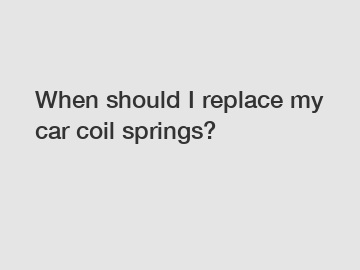When should I replace my car coil springs?
When should I replace my car coil springs?
Car coil springs play a crucial role in maintaining the stability and comfort of your vehicle. However, like any other mechanical component, they wear out over time due to continuous use and exposure to various road conditions. It is essential to know when it's time to replace your car coil springs to ensure optimal performance and safety. In this article, we will discuss the signs that indicate your coil springs may require replacement.
Unusual noises and vibrations.

One of the most common signs of worn-out coil springs is unusual noises and vibrations while driving. If you hear clunking, creaking, or squeaking noises coming from the suspension system, it could be an indication that the coil springs are damaged or weakened. Additionally, if you feel excessive vibrations while driving, especially when going over bumps or uneven surfaces, it could be a sign that the coil springs are no longer able to absorb shocks effectively. These symptoms should not be ignored as they can lead to further damage to the suspension system.
Uneven tire wear.
Another indicator that your car coil springs need replacement is the presence of uneven tire wear. Worn-out coil springs can cause your vehicle to sag on one side, leading to uneven weight distribution across the tires. This uneven weight distribution can result in irregular tire wear patterns, such as excessive wear on the inner or outer edges of the tires. If you notice these wear patterns, it is crucial to have your coil springs inspected and replaced if necessary to prevent further tire damage and improve overall vehicle performance.
Dips, nose-dives, and body rolls.
If you experience significant dips, nose-dives, or body rolls when braking, accelerating, or turning, it could be a sign of worn-out coil springs. Coil springs are responsible for maintaining the height and stability of the vehicle. When they become weak or damaged, the vehicle may exhibit an unnaturally low front end during braking, a nose-dive sensation when accelerating, and excessive body roll during cornering. These symptoms not only affect the handling and performance but also compromise your safety on the road.
Visible damage or sagging.
Visually inspecting your coil springs is another way to determine if replacement is necessary. Take a look at the coil springs for any visible signs of damage, such as rust, cracks, or breaks. Additionally, if you notice that your vehicle sits lower than usual or appears to sag on one side, it may indicate that the coil springs have lost their strength and need to be replaced.
Conclusion.
Regular inspection and maintenance of your car's suspension system, including the coil springs, are essential for the safety and performance of your vehicle. Pay attention to the signs discussed in this article, such as unusual noises, vibrations, uneven tire wear, dips, nose-dives, body rolls, and visible damage or sagging. If you observe any of these symptoms, it is recommended to have your coil springs inspected and replaced if necessary by a certified mechanic.
If you have any questions or concerns about your car's coil springs or any other automotive issues, feel free to contact us. Our team of experts is always here to assist you and provide professional advice to keep your vehicle running smoothly and safely.
Are you interested in learning more about Custom Made Automotive Coil Springs Price, Coil springs for commercial vehicles, metal car compression springs? Contact us today to secure an expert consultation!


